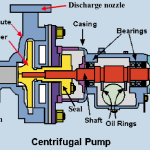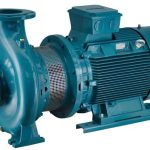Casings
Description: centrifugal-pumps
Figure 4: Cut-Away of a Pump Showing Volute Casing
Casings are generally of two types: volute and circular. The impellers are fitted inside the casings.
Volute Casings
Volute casings build a higher head; circular casings are used for low head and high capacity. A volute is a curved funnel increasing in area to the discharge port as shown in Figure 4. As the area of the cross-section increases, the volute reduces the speed of the liquid and increases the pressure of the liquid. One of the main purposes of a volute casing is to help balance the hydraulic pressure on the shaft of the pump. However, this occurs best at the manufacturer’s recommended capacity. Running volute-style pumps at a lower capacity than the manufacturer recommends can put lateral stress on the shaft of the pump, increasing wear-and-tear on the seals and bearings, and on the shaft itself. Double-volute casings are used when the radial thrusts become significant at reduced capacities.
Circular Casings
Circular casing have stationary diffusion vanes surrounding the impeller periphery that convert velocity energy to pressure energy. Conventionally, the diffusers are applied to multi-stage pumps.
Description: centrifugal-pumps
Figure 5: Solid Casing
The casings can be designed either as solid casings or split casings. Solid casing implies a design in which the entire casing including the discharge nozzle is all contained in one casting or fabricated piece. A split casingimplies two or more parts are fastened together. When the casing parts are divided by horizontal plane, the casing is described as horizontally split or axially split casing. When the split is in a vertical plane perpendicular to the rotation axis, the casing is described as vertically split or radially split casing. Casing Wear rings act as the seal between the casing and the impeller.


